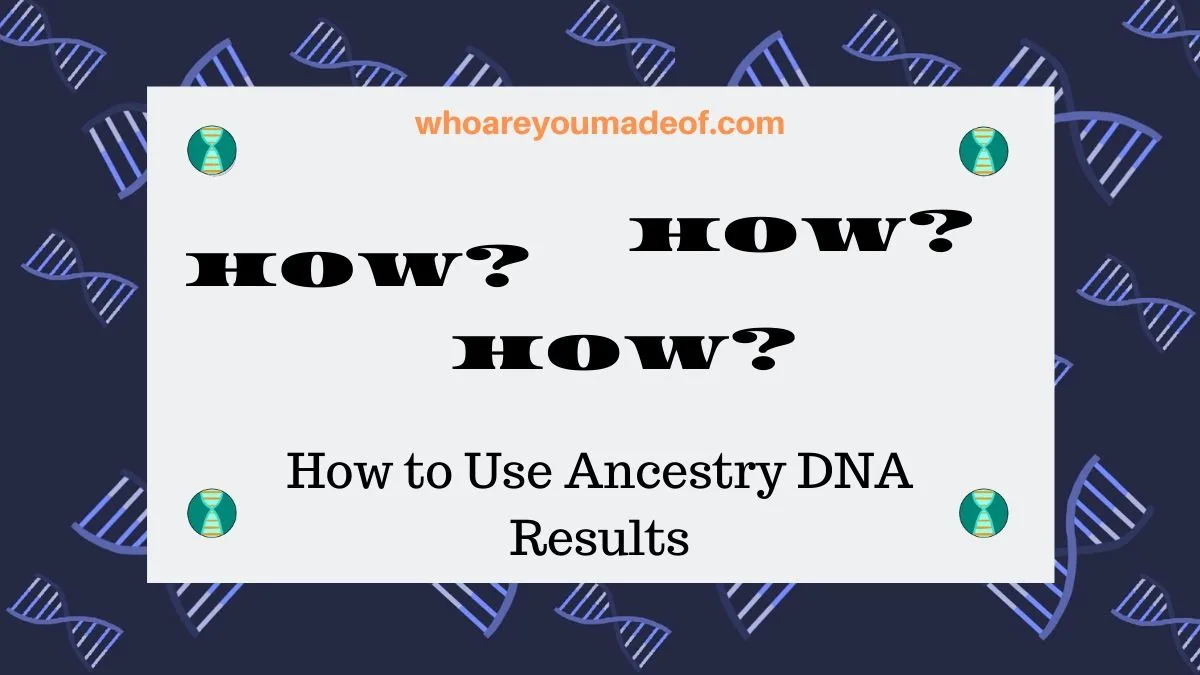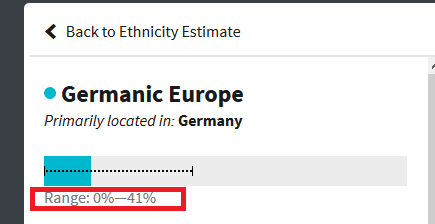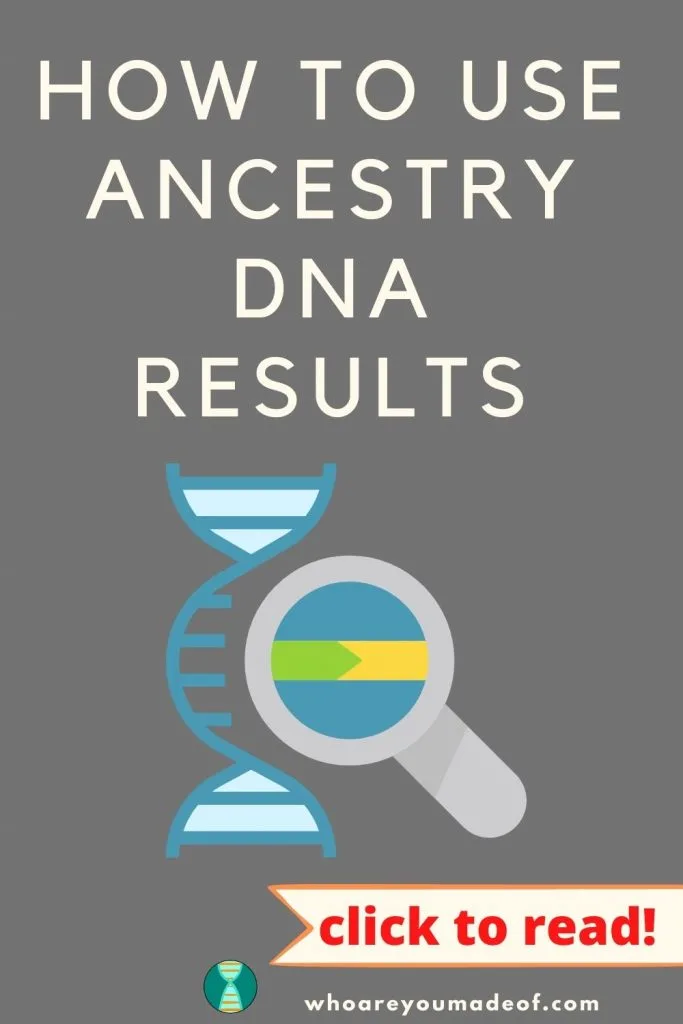Are you wondering how to use Ancestry DNA results? In this post, I will explain how get the most from all major elements of Ancestry DNA results.
You'll learn:
- How to use Ancestry DNA matches
- How to use Ancestry DNA ethnicity estimates
- How to use Ancestry DNA Thrulines
Plus, you'll find out some helpful next steps that you can take to make sure that you get the most from your DNA testing experience.

Your DNA results can help you get a general idea about where your ancestors were from, or build a twelve-generation family tree. It's all up to you, and this post should help you get started.
How to use Ancestry DNA matches
My absolute favorite aspect of Ancestry DNA results are the DNA matches. These are, believe it or not, the most valuable aspect of your DNA results.
Your DNA matches can help you find living relatives, learn about your ancestors, build your family tree and verify existing genealogical research. The DNA match list is a powerhouse of information.
In order to get the most from your DNA match list, take the following steps:
- Examine your top three matches that are already known to you
- Take a look at your top three matches that are unknown to you
For each match, there are several things that you can do to either figure out how the person might be related to you or if your shared DNA falls within the expected range:
- Check out your shared matches to see which family members you have in common
- Take a peek at their family tree to see if you spot any common surnames
- Plug your "shared centimorgans" into the following calculator to get more information on your DNA relationship: DNA Painter Calculator
In addition to carefully examine your top several matches, it is a good idea to learn how to filter and sort your Ancestry DNA matches to make it easier to find what you are looking for.
How often does Ancestry update DNA matches?
Even though you likely have many thousands of Ancestry DNA matches, you might find that certain lines of your family are better represented among your matches than others.
The DNA matches that you are looking for might not have done their DNA with Ancestry just yet. If they do test, however, they'll show up as soon as their results are ready.
Your Ancestry DNA match list is updated as soon as a new DNA match's test results have been completely analyzed. As new matches come available, you can log in to your DNA match list to examine them.
I recommend checking your DNA matches at least once a month to see what's new.
How to use Ancestry DNA ethnicity estimate
Our Ancestry DNA ethnicity estimate is called our "DNA Story". The main focus on our DNA Story is the ethnicity estimate.
We inherit an equal amount of DNA from each of our parents. The ethnicity regions that we see on our results are inherited from both our mother and father.
Even so, we don't inherit all of our mother and father's DNA. For example, we will only inherit a randomly selected 50% of our father's DNA.
This means that we might inherit a lot of a region that we expect to see, and less of some our father's smaller regions. Conversely, we might inherit more of his smaller regions and a smaller percentage of his main regions.
Each region on the Ancestry DNA ethnicity estimate has a unique history and covers a distinct geographic region. It's important to take the time to look at the map for each of your regions in order to learn the countries that the region covers.
The second most important thing that I can recommend readers do with their ethnicity estimate is click on each ethnicity region in order to see the range of percentages that are likely for that region.
For example, see below:

It seems as if I could have as little as 0% and as much as 41% Germanic Europe DNA.
Can Ancestry DNA ethnicity estimates change?
While your DNA remains the same, the technology and science used to determine where your ancestors lives is continually updating as new research becomes available.
This means that your Ancestry DNA ethnicity estimate might occasionally change. It doesn't mean that your previous results were "wrong", however.
Instead, the newer, updated results are "more correct" than they were before.
The science behind ethnicity estimates is relatively new, and so it's good that DNA testing companies take accuracy seriously. We should check out ethnicity estimates once or twice a year, or more, to see if any important updates have occurred.
How to use Ancestry DNA Thrulines
Our Ancestry ThruLines can help us identify potential ancestors, find DNA matches who are descended from known ancestors, and help us learn more about who should be included on our family tree.
ThruLines work by leveraging the power of Ancestry's millions of public and private family trees and the biggest non-governmental DNA testing database.
In order for Ancestry DNA ThruLines to show up on our results, we need to have a searchable family tree attached to our DNA results. The further back the tree goes, the more ThruLines we will have.
Additionally, you must have elected to participate in DNA matching when you first submitted your DNA sample. If you didn't opt-in to matching and you would like to change this setting, you can do so on your test settings page.
Steps for getting the most from your ThruLines:
- Click on each individual ThruLine to see which of your DNA matches are also descended from the ancestor, and add them to your family tree
- Consider getting an Ancestry subscription in order to evaluate your ThruLines more thoroughly and get access to family trees used for the creation of hte ThruLine
When you are checking through your ThruLines, you will notice that some of your ThuLines have a solid outline around their profile and others don't. The dotted lines are suggested potential ancestors, and you should not add these individuals to your family tree before finding additional records as evidence that you are descended from them.
Ancestry ThruLines not working?
Ancestry recommends that you have at least four generations of ancestors in your family tree on Ancestry in order for ThruLines to work properly. If you haven't yet built a family tree on Ancestry, please read the following post to learn the first steps you should take:
If you don't have any Ancestry DNA ThruLines, or don't have as many as you think you should have, I would recommend taking the following steps:
- Make sure you have a family tree attached to your DNA results
- Make sure that you have opted in to DNA matching
- See if you can build your family tree back a few more generations on as many lines as possible
- Ensure that your family tree on Ancestry is searchable (do this in tree settings)
- Give Ancestry's servers 24-48 hours to propagate updates, if you have made recent changes in your family tree or have only recently attached your DNA results to your tree
Further reading on Ancestry ThruLines
If you would like to learn more about Ancestry ThruLines, you can read the following posts on this website that should help you learn what you need to know:
- What are ThruLines on Ancestry?
- What can you learn from Ancestry ThruLines
- Are Ancestry ThruLines accurate?

Conclusion
I hope that this post has helped you understand more about how to use all three elements of your Ancestry DNA results. Plus, I hope that you got some ideas about what to do next.
If you have any questions about something that you read in this post, or if you would like to share your own tips about how to use Ancestry DNA results, please join us in the discussion below.
Thanks for stopping by!


Jane Richards
Wednesday 14th of September 2022
Thanks for this overview. I’ve recently taken up DNA testing as I have a friend from my biology lab class back in high school who found her long-lost brother through this. She didn’t think much of it until she got a call one day from her brother out of the blue. Turns out a coworker at furniture cleaner in Olympia helped him with all the work. To my knowledge, my friend and her brother are good friends and go out to lunch every month.
Lyn Glover
Tuesday 25th of February 2020
thanks heaps Mercedes - this was great reading and so useful
Mercedes
Thursday 5th of March 2020
Thank you so much!